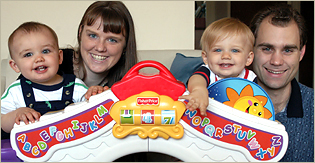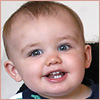When Josh and Laurie Anderson discovered last year that she was pregnant with twins, their reaction was typical.
"We were overwhelmed," recalled Josh, 31, a UCSF graduate student in biomedical sciences. "We wondered if we were ready for this."
Due to Josh's employment and familiarity with the University, the couple decided that UCSF was where they wanted to have their children born, but they soon learned that they'd also chosen one of the nation's foremost centers for caring for women pregnant with multiple births. Over the past three years, UCSF's team has delivered 55 sets of multiples.
The UCSF Twins and More Program coordinate a variety of services for women pregnant expecting two or more babies, all of whom are at higher risk for complications.
 |
| The Anderson family. Photo by Elisabeth Fall |
Laurie, 29, who works from home for a clinical research consulting company, was healthy, but women who are pregnant with multiples are at a statistically higher risk for developing high blood pressure and other problems. Multiple babies also are more likely to be born prematurely, have a low birth weight or develop birth defects.
Laurie was still golfing when she was 32 weeks -- eight weeks shy of a full term pregnancy. She also was having weekly pre-natal ultrasound tests to make sure the babies were healthy. At 36 weeks, she pulled a muscle in her back and went to the emergency room due to the pain and was transferred to labor and delivery.
Mari Paule Thiet, a perinatologist and chief of obstetrics at UCSF Medical Center, was on hand and realized that although Laurie's blood pressure was average for most people, it was too high for her. Laurie was admitted for 24 hours of observation before Thiet decided to induce labor. Laurie and Josh were thrilled that Thiet and Jeannie Pimentel, RN, who teaches the Parents of Twins class, were on hand for the delivery, although their shifts were over.
At many hospitals, twins and other multiples are always delivered via Caesarian section in which the babies are surgically removed from the womb. At UCSF Medical Center, vaginal delivery is permitted if the mother and babies are healthy enough for it and Laurie was well enough.
The twins, Stephen, weighing six pounds, 12 ounces, and Nicholas, five pounds, eight ounces, were born at 6:02 p.m. and 6:10 p.m., respectively. Nicholas was a breech extraction, which means that he was set to exit the womb feet first instead of headfirst. The obstetrician had to reach inside the uterus to pull him out by his feet for delivery. The Andersons remember that there were about a dozen staff people in the room ready to step in for any emergency during the delivery.
Josh had already taken the two babies out of the delivery room when the staff noticed that Laurie's blood pressure was dropping and she was hemorrhaging. The team quickly recognized the complication and Laurie received a blood transfusion and other measures to stabilize her blood pressure.
Fortunately, both twins and Laurie were ready to go home just three days after delivery. The boys, both healthy from birth, are fraternal twins, meaning that they started off as separate eggs that happened to be fertilized at the same time. In addition to being different sizes - Stephen continues to be bigger than his brother - the boys have different physical features and personalities.
"Whatever Stephen has, Nicholas wants," Laurie says.
She and the boys have since joined a playgroup of other twins and their moms.
"Four out of the six moms in the group delivered at UCSF," Laurie added. "We all think the support and care at UCSF was really great."
UCSF services for women expecting twins or more include access to perinatalogists, obstetricians who have special training in treating complications during pregnancy; a special education program for prospective parents of multiples; a nutritionist; a special phone line for questions; a full range of prenatal tests; and more frequent check-ups, in addition to the Great Expectations educational series and other services offered to all of UCSF's pregnant patients and their families.
The babies also have immediate access to UCSF Children's Hospital, located on three floors of UCSF Medical Center, which pioneered many of the advances in caring for at-risk newborns, including having one of the first neonatal intensive care units (NICU) in the nation.
Thiet says the program offers women like Laurie a one-stop location for ultrasound checks, prenatal tests, education and other services in one visit to the medical center.
"Everything is done in one central location," she said. "It's just a great idea to have integrated care so women can get all the care that multiple births require in one place."
Source: Sandra Burnett
Related Links
UCSF Medical Center



